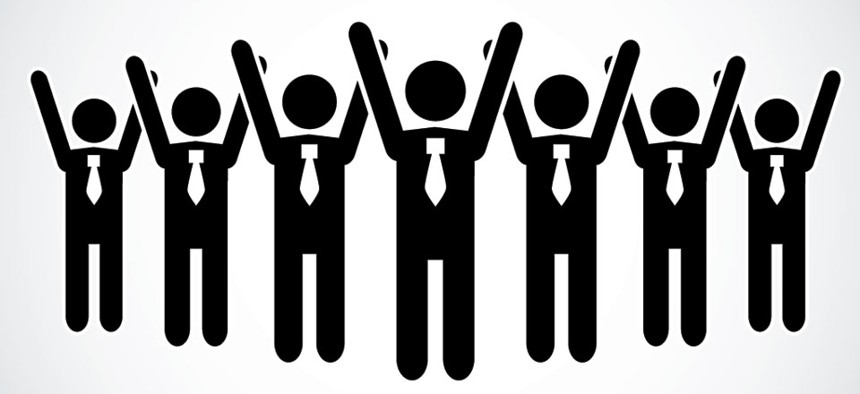Though the “open plan” modern office , with its sea of desks, might look like the offspring of a newsroom or a trading floor, it can also trace its heritage to 1960s Germany. There, two brothers who worked in their father’s office-furniture business kicked off the Bürolandschaft, or “office landscape,” movement, which sought to boost communication and efficiency and de-emphasize status. As the idea took hold in North America in the decades that followed, employers switched from traditional offices with one or two people per room to large, wall-less spaces. By the turn of the century, roughly two-thirds of U.S. workers spent their days in open-plan offices [1] .
But as the layout became commonplace, problems emerged. A 2002 longitudinal study of Canadian oil-and-gas-company employees who moved from a traditional office to an open one found that on every aspect measured, from feelings about the work environment to co-worker relationships to self-reported performance, employees were significantly less satisfied in the open office [2] . One explanation for why this might be is that open offices prioritize communication and collaboration but sacrifice privacy. In 1980, a group of psychology researchers published a study suggesting that this sacrifice might have unintended consequences. They found that “architectural privacy” (the ability to close one’s door, say) went hand in hand with a sense of “psychological privacy” (feeling “control over access to oneself or one’s group”). And a healthy dose of psychological privacy correlated with greater job satisfaction and performance [3] .
With a lack of privacy comes noise—the talking, typing, and even chewing of one’s co-workers. A 1998 study found that background noise, whether or not it included speech, impaired both memory and the ability to do mental arithmetic [4] , while another study found that even music hindered performance [5] . There’s also the question of lighting. Open offices tend to cluster cubicles away from windows, and a forthcoming study shows that on workdays, employees without windows get an average of 47 fewer minutes of sleep than those with windows, and have worse sleep quality overall [6] . Artificial light has its own downsides. One pair of researchers found that bright overhead light intensifies emotions, enhancing perceptions of aggression and sexiness—which could lead to a lack of focus during meetings if arguments get heated, or co-workers get overheated [7] .
To add another tangle to this knot, different personality types respond differently to the conditions of office life. For example, the study on background music found its negative effects to be much more pronounced for introverts than for extroverts. Even the office coffee machine could be hurting some employees. Although a moderate dose of caffeine was recently found to enhance long-term information retention [8] , caffeine has previously been shown to hinder introverts’ cognitive performance during the workday [9] .
Further complicating matters, cubicle dwellers are forever hunting for ways to improve their office experience. The latest craze is the standing desk, inspired by the widely reported health risks of sitting all day. One study found that people who sat at least six hours a day had a higher risk of premature death than those who sat three hours or fewer—regardless of physical-activity level [10] . But being on one’s feet presents its own health risks: standing for more than eight hours a day has been tied to back and foot pain, as well as preterm birth [11] .
So what’s a research-minded boss to do? Easy: Give employees their own private offices, with plenty of sun, and turn off the overhead lights. Supply the introverts with noise-canceling headphones and decaf, but pump the extroverts full of caffeine and even let them listen to music now and then. And don’t let any of us sit too much—or stand too much. Maybe we can crouch.
The Studies:
[1] “Space and Project Management Benchmarks” (International Facility Management Association, 2010)
[2] Brennan et al., “Traditional Versus Open Office Design” ( Environment and Behavior , May 2002)
[ 3] Sundstrom et al., “Privacy at Work: Architectural Correlates of Job Satisfaction and Job Performance” ( Academy of Management Journal , March 1980)
[4] Banbury and Berry, “Disruption of Office-Related Tasks by Speech and Office Noise” ( British Journal of Psychology , 1998)
[5] Furnham and Strbac, “Music Is as Distracting as Noise” ( Ergonomics , 2002)
[6] Cheung et al., “Impact of Workplace Daylight Exposure on Sleep, Physical Activity, and Quality of Life” ( Sleep , Abstract Supplement, 2013)
[7] Xu and Labroo, “Incandescent Affect: Turning on the Hot Emotional System With Bright Light” ( Journal of Consumer Psychology , April 2014)
[8] Borota et al., “Post-Study Caffeine Administration Enhances Memory Consolidation in Humans” ( Nature Neuroscience , Feb. 2014)
[9] Revelle et al., “The Interactive Effect of Personality, Time of Day, and Caffeine” ( Journal of Experimental Psychology: General , March 1980)
[10] Patel et al., “Leisure Time Spent Sitting in Relation to Total Mortality in a Prospective Cohort of US Adults” ( American Journal of Epidemiology , Aug. 2010)
[11] McCulloch, “Health Risks Associated With Prolonged Standing” ( Work , Jan. 2002)
( Image via Gazlast / Shutterstock.com )



